SEO audit and reporting is a process to determine your site’s SEO ranking. In a broader sense, it analyzes a website to determine its strengths and weaknesses. It’s a way for a company or individual to evaluate the effectiveness of their SEO strategy and make adjustments accordingly.
An SEO audit aims to identify areas that need improvement and provide recommendations for fixing them. Sometimes, an audit will also include recommendations on what changes need to be made for the site to rank higher in search engine results pages (SERPs).
Quick Links
What is SEO Audit and Reporting
An SEO audit is a process of analyzing a website’s performance in search engines, with the goal of identifying any issues or areas for improvement.
This typically involves analyzing the site’s technical elements (such as the structure and navigation), as well as its content and backlink profile.
An SEO report is a document that summarizes the findings of an SEO audit and provides recommendations for how to improve the site’s search engine visibility.
For example, during an SEO audit, a website’s code might be reviewed to avoid those mistakes which ruined customers’ experience. The audit might also check for common on-page SEO issues, such as missing title tags or duplicate content.
Once the audit is complete, an SEO report would be generated that highlights any issues that were found and provide specific recommendations for how to fix them.
For example, if the audit found that the site’s title tags were missing or poorly optimized, the report might recommend updating them with more descriptive and relevant text.
Additionally, an SEO audit and report might also include an analysis of the website’s backlink profile. This includes identifying the number of backlinks pointing to the website, the quality of those backlinks, and how the website is performing when compared to competitors.
An SEO audit and report is a crucial step in improving a website’s search engine visibility, it can help identify areas of a website that need improvement, and provide guidance on how to make those improvements
SEO Audit
An SEO audit is a process of analyzing a website’s performance in search engines, with the goal of identifying any issues or areas for improvement.
The audit typically involves analyzing the site’s technical elements (such as the structure and code), on-page (content and keywords) off-page (backlink profile), and customer engagement metrics.
SEO Audit Report
An SEO audit report is a document that summarizes the findings of an SEO audit, and provides recommendations for how to improve the site’s search engine visibility.
It is a detailed document which provide insights on various aspects of website optimization, including technical issues, content and backlinks that impact search engine visibility.
In summary, SEO audit is the process of analyzing a website and SEO audit report is the document that summarizes the findings and recommendations from the audit process.
Why SEO Audit and Reporting is important
There are many reasons why an SEO audit and report matter. The following section provides an overview of what an SEO audit entails and how it can help you improve your website’s performance in search engine results pages (SERPs).
Gathering information about a client’s current website performance is the first step in conducting an SEO audit. The next step would be analyzing this information to identify areas where improvements could be made.
These improvements may include content creation to fill the gap, on-page optimization, off-page optimization, or technical optimizations such as indexing issues or broken links. Once necessary changes have been made, they should be tested thoroughly before implementing them on the live site.
1)- Understanding your website’s strengths and weaknesses is necessary.
2)- Identify opportunities for improvement.
3)- Make sure that Google crawls your site in a way that is most likely to rank it higher.
4)- Confirm the hypothesis that you have a successful website.
5)- Establish the baseline and determine where your website needs to be to achieve its goals.
6)- Plan the marketing campaign needed to get there.
7)- Improve website performance.
8)- Measure growth, compare to previous reports, and see the impact of your marketing campaign.
9)- Track how much money you spend to determine if you are getting value for your money.
10)- Track how much time you spent on the website to determine if it is worth the effort.
11)- Document your SEO efforts for later use.
12)- Identify and fix any errors or inefficiencies.
The need for SEO audits and reporting has increased in recent years. The reason behind this is the increased usage of the internet and the growing importance of search engine optimization.
As a result, many more people use the internet to find information, research, buy products and services, and communicate with others.
SEO Audit Checklist
SEO audits are essential for any business that wants to stay ahead of the competition. They help you identify areas of improvement and make sure that your website is optimized for search engines.
Conducting an effective and comprehensive SEO audit requires a thorough understanding of the latest search engine algorithms, keyword research, content optimization, link building strategies and more.
By conducting an SEO audit, you can gain valuable insights into your website’s performance and make necessary changes to improve its visibility in organic search results.
On-Page SEO Audit
An On-Page SEO Audit is the process of analyzing and optimizing the content and structure of a website to improve its visibility in search engine results.
It typically includes analyzing elements such as content quality, keyword density and placement, content gap and structure, plagiarism, readability, headings and subheadings, and formatting.
Off-Page SEO Audit
An Off-Page SEO Audit is the process of analyzing and optimizing external elements that affect the visibility of a website in search engine results.
It typically includes analyzing the website’s backlink profile, anchor text, link diversity, social signals, brand mentions, domain authority, directories, online reviews, and competitor analysis.
Technical SEO Audit
A Technical SEO Audit is the process of analyzing and optimizing the technical elements of a website to improve its visibility in search engine results.
It typically includes analyzing crawlability, site structure, URL structure, canonicalization, mobile optimization, speed optimization, hreflang tags, structured data, security, and analytics.
In summary, On-Page SEO Audit is the process of analyzing and optimizing the internal elements of the website, Off-Page SEO Audit is the process of analyzing and optimizing the external elements that affect the visibility of a website and Technical SEO Audit is the process of analyzing and optimizing the technical elements of a website.
On-Page SEO Audit
On-Page SEO Audit is the process of evaluating a website’s content and structure to improve its visibility and ranking in search engine result pages (SERPs).
It involves analyzing the website’s content, code, structure, and links to determine if it meets best practices for SEO.
The goal of an On-Page SEO Audit is to identify any areas of improvement that can be made in order to increase the website’s ranking on SERPs.
By making changes to these areas, a website can improve its chances of appearing higher in search engine results.
1)- Keywords Report and Analysis
A website keyword audit is the process of analyzing the keywords used on a website in order to improve its search engine visibility. This typically involves identifying the most important keywords for the website, and then analyzing how those keywords are used on the site.
This can include looking at:
Keyword density
The percentage of times a keyword appears on a webpage compared to the total number of words on that page.
Keyword placement
The location of a keyword on a webpage, including in the title tag, meta description, headings, and body content.
By analyzing the keywords used on a website and optimizing them for search engines, a website can improve its search engine visibility and ranking.
2)- Website Content Audit
Quality: Ensure that the website’s content is high-quality, relevant, and provides value to users.
Relevance: Assess the relevance of the website’s content to the target audience and the website’s overall goals.
Dupe Content: Check for duplicate content on the website, and ensure that it is properly handled with canonical tags or redirects.
Content structure: Ensure that the website’s content is organized in a logical and easy-to-understand way, with clear headings and subheadings.
Formatting: Ensure that the website’s content is properly formatted, with appropriate use of headings, lists, images, and other elements.
Readability: Check that the website’s content is easy to read and understand, with a clear writing style and appropriate use of language.
Content optimization: Optimize the website’s content for search engines by including keywords and meta tags where appropriate.
Freshness: Ensure that the website’s content is up-to-date and that new content is added regularly.
Headings and subheadings: Proper use of headings (H1, H2, etc.) can help organize the content and make it easier for users and search engines to understand.
- Content gaps: Identify content gaps on the website, and develop a plan to fill them with new, relevant content.
Technical-Page SEO Audit
A technical SEO audit is a comprehensive analysis of a website’s technical infrastructure and configuration to identify and fix any issues that may be negatively impacting the website’s search engine visibility and performance.
The goal of a technical SEO audit is to identify and resolve any technical barriers that may be preventing search engines from crawling and indexing a website’s content, or that may be negatively impacting the user experience.
1)- Core Web Vitals
Core Web Vitals are a set of metrics defined by Google that measure the user experience of a website.
These metrics are designed to help web developers and website owners understand how their site is performing from a user’s perspective and to identify and fix any issues that might be negatively impacting the user experience.
The Core Web Vitals include:
- Largest Contentful Paint (LCP): measures loading performance.
- First Input Delay (FID): measures interactivity.
- Cumulative Layout Shift (CLS): measures visual stability.
These metrics are intended to help website owners and developers identify and fix issues related to speed, responsiveness, and visual stability, and improve the overall user experience of their website.
Page Speed
Speed optimization: Websites should be optimized for fast loading times to improve the user experience and to rank well in search results.
Mobile optimization
Websites should be optimized for mobile devices to ensure a good user experience and to rank well in mobile search results.
Internal and External Links
Internal and external links can help users navigate a website and can also signal to search engines which pages are important and trustworthy.
Safety and Security
Ensure that the website is secure by implementing SSL/TLS (secure sockets layer and transport layer security) encryption and regularly checking for vulnerabilities.
Crawlability
Ensure that search engines can easily crawl and index the website by checking for proper use of robots.txt, XML sitemaps, and other crawl directives.
Schema Markup
Schema markup can help search engines understand the content on a webpage and can also improve the appearance of rich snippets in the search results.
2)- Website Architecture
Website architecture refers to the way in which a website is organized and structured. It encompasses the organization of a website’s pages and content, as well as the way in which those pages and content are linked together.
A well-designed website architecture can help users easily find the information they are looking for, and can also improve a website’s search engine visibility.
Website architecture typically includes:
Information architecture: the organization and labeling of website content to make it easy for users to find what they are looking for.
Navigation: the menu structure that allows users to move between different pages on a website.
URL structure: the organization of a website’s URLs, including the use of hierarchical structures and descriptive keywords in URLs.
Internal linking: the linking of pages within a website to make it easy for users and search engines to understand the relationships between different pages.
Sitemap: An XML file that lists all the URLs of a site, which are accessible to search engine crawlers, it helps search engines understand the structure of a website.
A well-designed website architecture can improve the user experience, and make it easier for search engines to crawl and index a website’s content, which can help to improve the website’s search engine visibility.
Site Structure
Ensure that the website is organized in a logical and easy-to-understand way, with a clear hierarchy of pages and categories.
Social Tags
Proper use of social tags (e.g. Open Graph tags) can help control how a webpage is shared on social media.
Tags and Meta Descriptions
These tags provide information about a webpage to search engines and users, and should be unique and descriptive.
Canonicalization
Ensure that there are no issues with duplicate content by implementing proper canonical tags and redirects.
URL structure
URLs should be clean and easy to understand, consistence, simple, short, concise, relevant with the page content and should include keywords where appropriate.
Hreflang Tags
Implement hreflang tags to indicate to search engines which version of a webpage should be shown to users in different languages or regions.
Off-Page SEO Audit
An Off-page SEO audit is a comprehensive analysis of a website’s external factors that may be impacting its search engine visibility and performance. The goal of an off-page SEO audit is to identify and analyze the website’s external factors such as backlinks, social media presence, and online reputation, which can have an impact on search engine rankings.
Competitor Analysis
Analyze the backlink profiles and off-page SEO strategies of the website’s competitors, and identify opportunities to outrank them.
Organic Traffic and Keywords Positions
Analyze the organic traffic flow and keywords positions of the website, it includes recent position changes and solutions.
Backlink Profile
Analyze the number and quality of backlinks pointing to the website, and identify any potentially harmful or low-quality links.
Anchor Text
Analyze the anchor text of the backlinks pointing to the website, and ensure that they are natural and diverse.
Link Diversity
Ensure that the website has a diverse set of backlinks from a variety of sources, such as social media, directories, and other websites.
Social Signals
Monitor the website’s social media presence, including likes, shares, and followers, and ensure that it is active and engaging.
Link Relevance
Analyze the relevance of the backlinks pointing to the website. The more relevant the links are, the more valuable they will be to the website’s search engine visibility.
Local SEO
Local SEO includes analyzing the website’s local search optimization, including Google My Business, local content marketing, NAP (name, address, and phone number), and local citations.
Brand Mentions
This includes analyzing the website’s brand mentions across the internet and assessing the sentiment behind them.
Domain Authority
Check the domain authority of the website and its competitors to understand the relative strength of their backlink profiles.
Directories
Check that the website is listed in relevant directories and that the listings are accurate and up-to-date.
Online Reviews
Monitor the website’s online reviews and ratings, and ensure that they are positive and that any negative reviews are addressed.
The goal of an off-page SEO audit is to identify any external factors that may be negatively impacting the website’s search engine visibility and performance, and to provide recommendations for improving the website’s online reputation and building high-quality backlinks in order to improve the website’s overall search engine optimization.
Measuring Customer Experience
Customer engagement refers to the level of interaction and involvement that a customer has with a company or brand. This can include activities such as visiting a website, using a product or service, or participating in marketing campaigns.
Measuring customer engagement can help companies understand how well they are connecting with their target audience and identify areas for improvement. Some examples of metrics that can be used to measure customer engagement include website traffic, conversion rates, social media engagement, and customer feedback.
Customer Experience (CX) measurement is the process of evaluating how customers interact and perceive a company, its products, and its services. This can include evaluating customer satisfaction, loyalty, and advocacy, as well as identifying pain points and areas for improvement.
Bounce Rate
Bounce Rate is the percentage of visitors who leave a website after only viewing one page. A high bounce rate can indicate that the website is not meeting the needs of its visitors.
Conversion Rate
Conversion Rate is the percentage of visitors who take a desired action, such as filling out a form or making a purchase. A high conversion rate is generally considered to be a positive indicator of a website’s effectiveness.
Click-Through Rate (CTR)
Click Through Rate is the percentage of visitors who click on a specific link or call-to-action. A high CTR can indicate that the link or call-to-action is effectively capturing the attention of visitors.
Dwell Time
Dwell Time is the amount of time a visitor spends on a website before leaving. A high dwell time can indicate that the visitor is engaged with the content on the website.
Unique Page View
Unique Page View is the number of distinct pages viewed by a user over a given period of time. It is an important engagement metric. Google Analytics will show you the unique page view and also assist you how to improve it.
Page Per Session
Page per session is the average number of pages a visitor views during a session on a website. A high number of pages per session can indicate that the visitor is exploring and engaging with the website’s content.
Net Promoter Score (NPS)
Net Promoter Score (NPS) is a measure of customer satisfaction and loyalty, calculated by asking customers how likely they are to recommend a product or service to others on a scale of 0-10.
Customer Reviews
Customer reviews are the feedback from customers about their experiences with a product or service. You can check reviews on Google and other third-party platforms like Trustpilot, and Sitejabber.
Video Engagement Metrics
Video engagement metrics are metrics like video views, watch time, completion rate, drop-off rate, engagement rate, etc. which helps to evaluate the audience engagement with the video content.
Exit Page
The exit page is the last page that a visitor views before leaving a website. The exit page can provide insight into where visitors are dropping off within a website.
In summary, customer engagement and customer experience measurement are important for understanding how well a company is connecting with its customers and identifying areas for improvement. While SEO is important for making sure that the website is easily discoverable by the audience and providing relevant information to them.
Tools for SEO Audit and Reporting
This guide will help you decide which SEO reporting and auditing tools are best for your needs.
We have compiled a list of SEO tools that offer various features to help you find what you need. We also looked at some of the most popular SEO tools in the industry to see how they compare and what they offer.
There are many SEO auditing tools available on the market. Some of them are free, some have a free trial, and some offer an advanced plan for a monthly fee. But what is the best SEO auditing tool for your business?
Let me share the ten easiest and free tools to create an SEO Audit report instantly:
Google Search Console
Google Search Console is considered the most authentic tool as Google has powered it. There are a lot of features, including crawled and indexed pages, visitor count, backlinks, social media shares, traffic, and more.
Ahref
Ahref is used by over 500,000 users globally.
Its features include monitoring SEO metrics from SERPs, crawl rate, backlinks, URL Rating (UR), Domain Rating (DR), and more.
SEMrush
SEMrush has more features than the other tools on this list. This tool is designed to help you find keywords, competitors’ SEO content, and rankings. It also gives you competitive intelligence with its competitive research tool.
Moz Pro
Moz Pro offers many features for your SEO needs, including keyword analysis, competitor research, backlink analysis, and many others that can help you get more traffic. In addition, it has both free and pro versions.
ScreamingFrog
It is designed for small business owners seeking help marketing their businesses.
It offers keyword research and tools for social media marketing, blogging, and content promotion.
WooRank
WooRank is a fully automated SEO audit and reporting tool. It provides you with a detailed report of your website’s SEO performance. In addition, this tool will create a personalized action plan for your website’s improvement.
Google Analytics
One of the most important aspects of running a website is ensuring it ranks well in search engines.
Google Analytics is a free and powerful tool that can help you identify where your site needs work to improve it.
SEOPtimer
SEOPtimer is an SEO audit and reporting tool. It helps marketers measure the performance of their SEO campaigns by tracking rankings, keyword positions, and organic traffic. In addition, SEOPtimer offers a free trial.
DeepCrawl
DeepCrawl is a platform for SEO professionals and web admins. It provides SEO audit and reporting tools that allow users to crawl the site from various angles and in an easy-to-use dashboard. DeepCrawl also offers expert advice on how to fix the issues found.
Ubersuggest
Ubersuggest is a tool for SEO audit and reporting. It helps with content discovery, keyword research, and competitor analysis.
Ubersuggest indexes the search engine results and uses their data to create a custom report containing suggestions for optimization.
Majestic
Majestic is a powerful SEO audit and reporting tool that collects data from the entire web and gives complete visibility into the performance of websites. In addition, majestic offers keyword research tools, backlink analysis, IP lookup tools, social media tracking, and more.
SpyFu
SpyFu is an SEO Audit and Reporting tool that provides keyword data, backlink data, and social media analytics for any domain or website.
SpyFu’s in-depth reports provide insight into competitor strategies, rank potential, and content analysis.
Customised SEO Reporting
The following is a guide to creating a successful SEO audit report:
1. Introduction and Summary
This should include the scope of the audit, the date of the audit, and any other pertinent information about the scope of work that you are undertaking.
2. On-Page SEO Report
In this section, you’ll provide analysis and recommendations for on-page optimization factors such as keyword research, title tags, and meta descriptions, among others, as well as recommendations for improving these elements on your website to maximize your ranking potential in search engine results pages (SERPs).
3. Technical SEO Report
This section will include an analysis of technical SEO factors, including but not limited to site speed, mobile friendliness, URL architecture, meta tags, content length, etc.
It should also include recommendations for improving your website’s performance in search engine rankings.
4. Off-Page SEO Report
In this section, you’ll provide analysis and recommendations for off-page optimization factors such as backlinks, link building, social media, and others.
You’ll also provide recommendations for improving these elements on your website to maximize your ranking potential in search engine results pages (SERPs).
5. Measuring Customer Experience
Customer experience is an important factor that needs to be taken into consideration when conducting an SEO audit. Measuring customer experience of a website can help you identify areas where improvement is needed and also provide insights on how to optimize the user experience.
By measuring customer experience, you can get a better understanding of how users interact with your website, what features they find useful and which ones are not meeting their expectations. This information can then be used to create an SEO audit report that highlights areas for improvement and provides recommendations on how to improve the overall user experience.
6. Future Roadmap and Strategy
This section provides a review of your current website and also provides recommendations for future SEO efforts. Please provide the exact roadmap to fix the mentioned issues and improve the website ranking, which ultimately leads to boosted traffic and conversion.
7. Time and Budget for SEO Campaign
When quoting prices and time for an SEO campaign, there are a few things to consider. First, the pricing and timeline can depend on factors such as the number of keywords, the keywords’ competitiveness, the campaign length, and more.
If the client asks for a quote, compile a detailed report and share it with the goal-oriented strategic approach by sharing the time and price for the tasks. The cost of an SEO campaign can be quoted in various ways.
It would be better to quote a lump sum price and then divide it into categories reflecting the price for each micro-task so that the client will be satisfied, and at the month or weekend, you can share the report of task accomplishment.
SEO Audit Report Sample
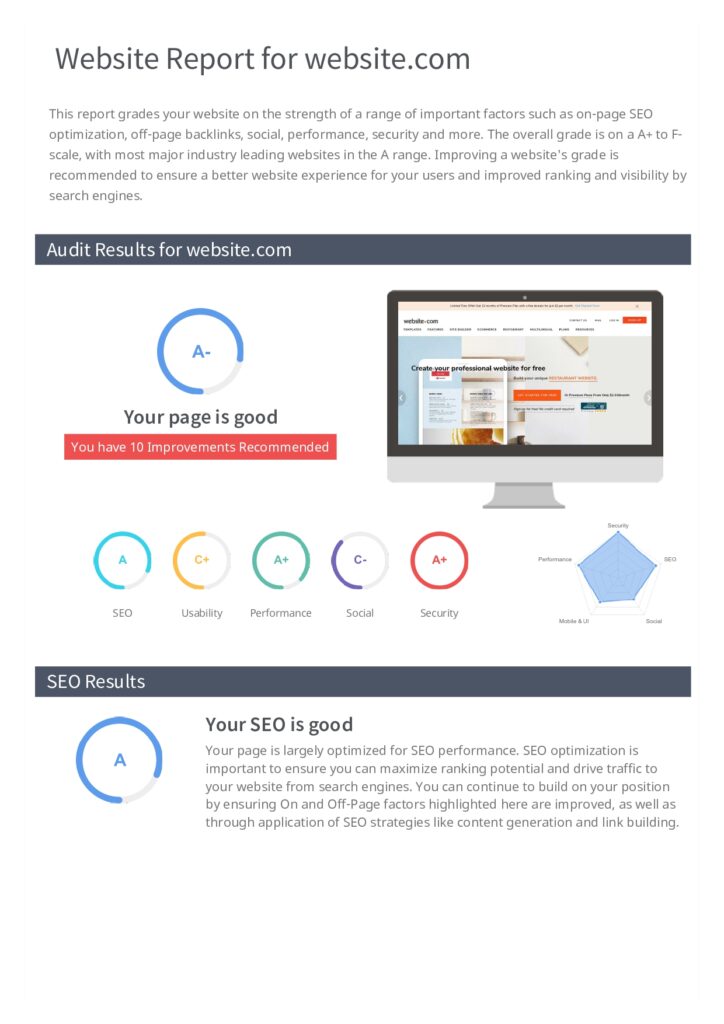
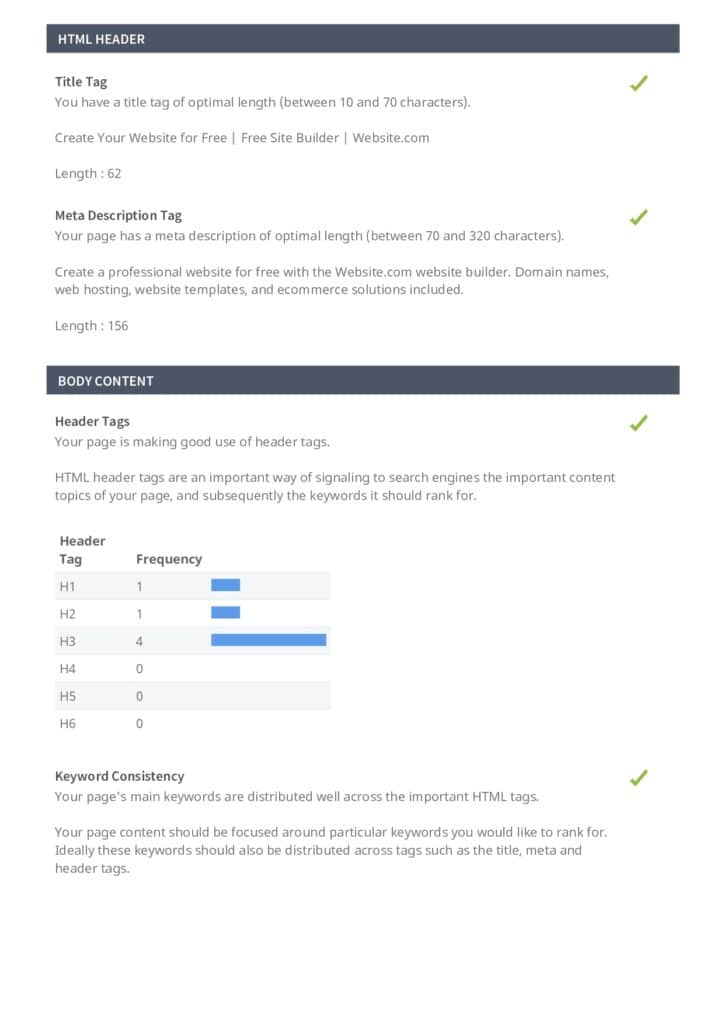
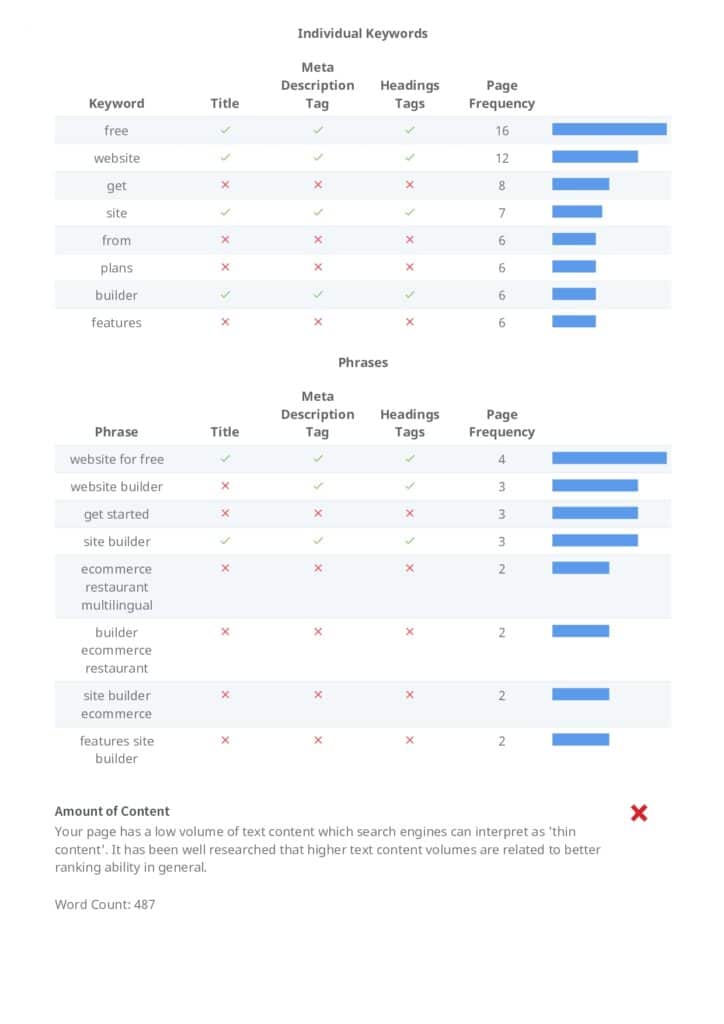

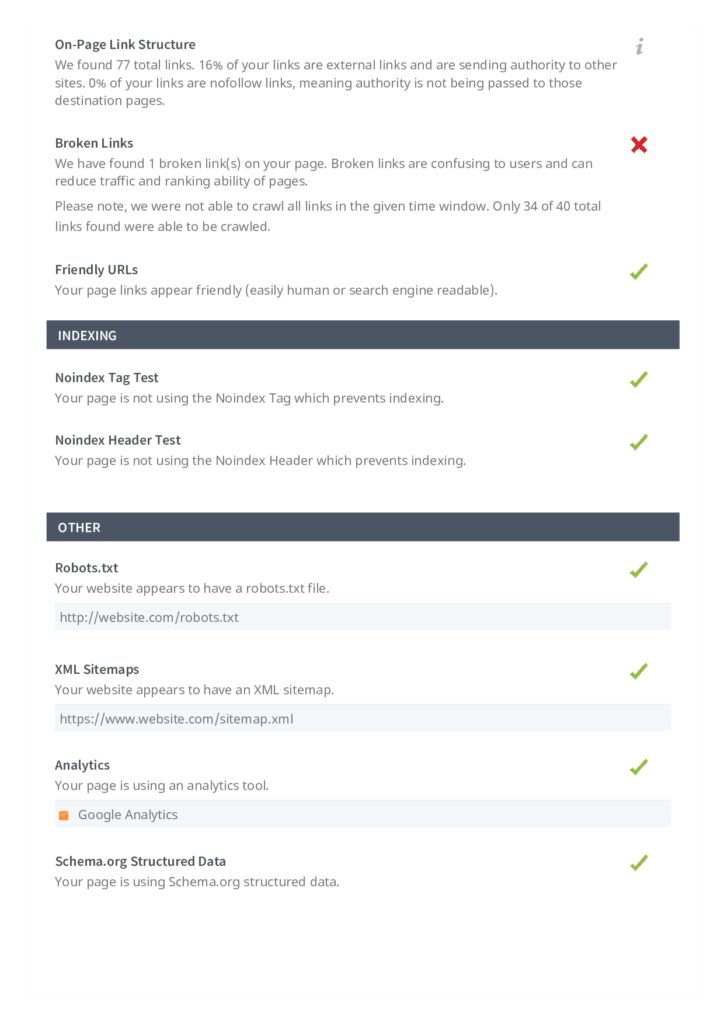

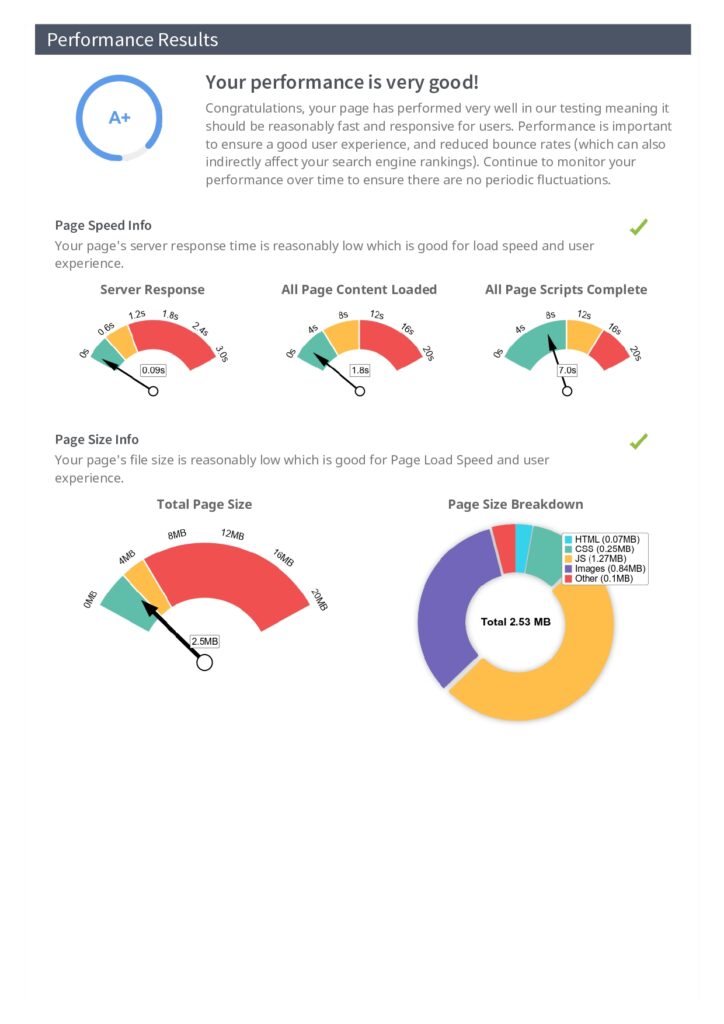
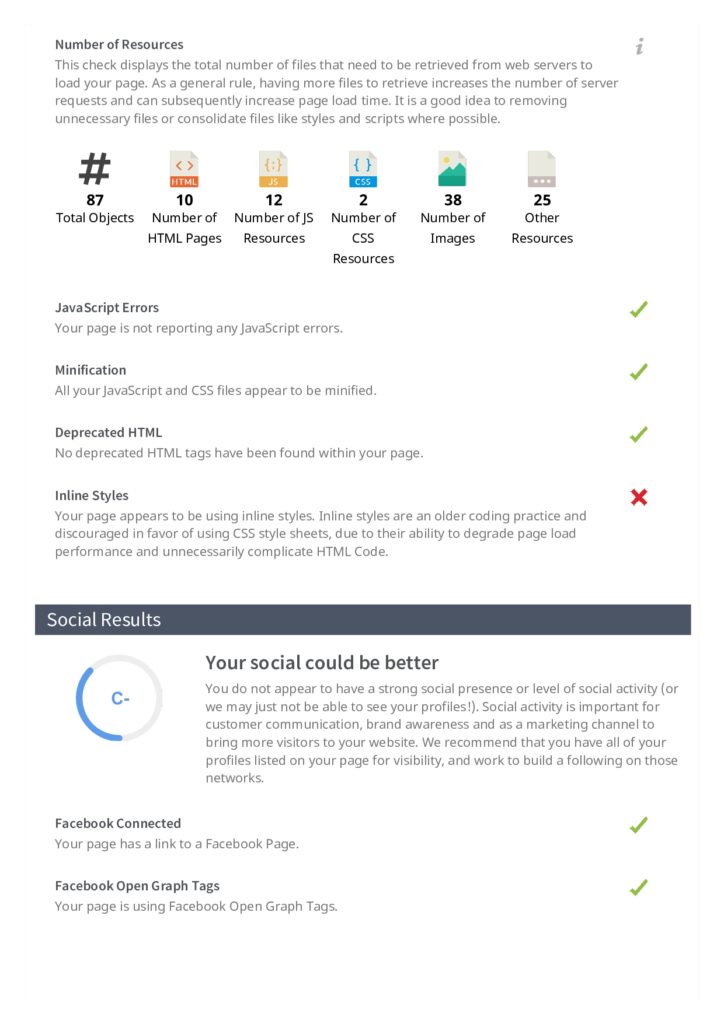
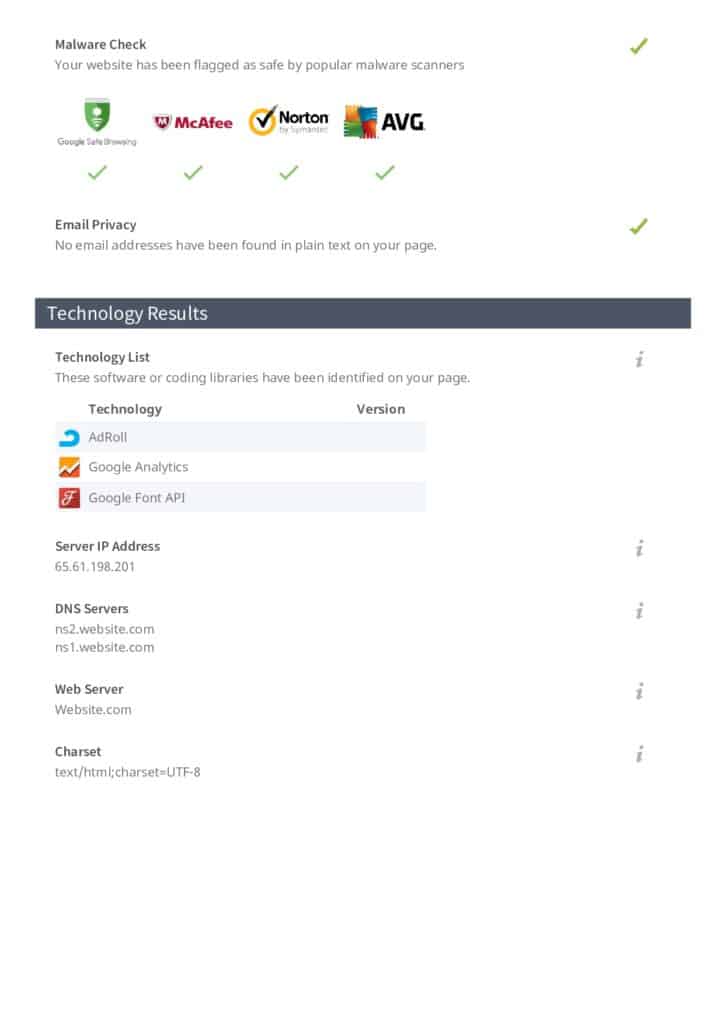

Final Thoughts
An SEO audit is a comprehensive analysis of a website’s search engine optimization (SEO) and its performance.
The goal of an SEO audit is to identify any issues that may be negatively impacting a website’s search engine visibility and performance and to provide recommendations for resolving those issues in order to improve the website’s overall search engine optimization.
The importance of an SEO audit lies in the fact that it helps website owners and developers understand how their site is performing from a search engine’s perspective, and identify areas for improvement.
A regular SEO audit can help to ensure that a website is always up-to-date with the latest best practices and is optimized for search engines.
There are different approaches to conducting an SEO audit, but generally, it involves analyzing both on-page and off-page factors.
On-page factors include:
- Website structure and architecture
- Content optimization
- On-page technical SEO
Off-page factors include:
- Backlink profile
- Social media presence
- Brand mentions
- Online Reputation
The parameters that need to be considered during an SEO audit include:
- Website structure and organization
- Content relevance and quality
- On-page technical SEO
- Mobile Optimization
- Website speed and performance
- Security Protocols
- Backlink profile
- Social media presence
- Online Reputation
- Local SEO
After conducting an SEO audit, recommendations for improvements are provided based on the analysis results. These recommendations may include changes to website structure and content, improvements to on-page technical SEO, and strategies for building high-quality backlinks and improving the website’s online reputation.
Many tools can be used to conduct an SEO audit, such as Ahref, Moz, SEMRush, or Google Search Console. These tools will provide valuable insights into how a website performs in search engine rankings.
Overall, an SEO audit is an important step in ensuring that a website is optimized for search engines and provides a positive user experience. It should be conducted regularly to keep the website updated with the latest best practices and to identify and address any issues that may be negatively impacting its search engine visibility and performance.
After conducting an SEO audit, it is recommended that you create reports on your findings to share them with other stakeholders inside your company or organization. Doing this will allow you to make better decisions about what needs to be improved on your site for better performance in search engine rankings.
Sharing is Caring

























